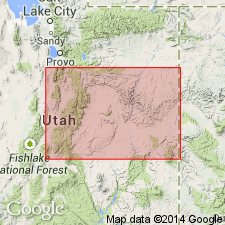
- Usage in publication:
-
- Steamboat Pass Shale Member*
- Modifications:
-
- Named
- Reference
- Dominant lithology:
-
- Shale
- Limestone
- AAPG geologic province:
-
- Great Basin province
Summary:
Named as a member of Orr Formation for Steamboat Pass, Wah Wah Mountains, Millard Co, UT in Great Basin province. Reference section designated and measured near Lawson Cove Reservoir, sec 24, T24S, R14W, northern Wah Wah Mountains. Can be mapped in the Cricket and Wah Wah Mountains in Great Basin province where Johns Wash Limestone Member of Orr Formation is absent and, as a result, Candland and Corset Shale Members of Orr cannot be distinguished. Not described at type section. Is composed of dark-gray, thin-bedded calcisiltite, dark-gray, thin-bedded calcarenite, and at top a light-olive-gray shale where it is 265 ft (80.8 m) thick. Overlies Big Horse Limestone Member (new) of Orr and underlies Sneakover Limestone Member (new) of Orr at reference section. Is of Late Cambrian age. Has yielded trilobite fossils. Correlates with: Opex Formation of East Tintic Mountains; Straight Canyon and Fera Formations of Dugway Range; Hicks Formation of Deep Creek Range, UT; and Lincoln Peak, Johns Wash, and Corset Spring Formations of southern Snake Range, NV.
Source: GNU records (USGS DDS-6; Denver GNULEX).
For more information, please contact Nancy Stamm, Geologic Names Committee Secretary.
Asterisk (*) indicates published by U.S. Geological Survey authors.
"No current usage" (†) implies that a name has been abandoned or has fallen into disuse. Former usage and, if known, replacement name given in parentheses ( ).
Slash (/) indicates name conflicts with nomenclatural guidelines (CSN, 1933; ACSN, 1961, 1970; NACSN, 1983, 2005, 2021). May be explained within brackets ([ ]).

